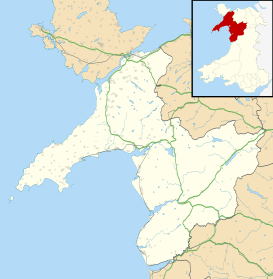Llanystumdwy
| Llanystumdwy | |
|---|---|
 Highgate | |
 Llanystumdwy Llanystumdwy shown within Gwynedd | |
| Population | 2,080 (2011) |
| OS grid reference | SH473385 |
| Community |
|
| Principal area | |
| Ceremonial county | |
| Country | Wales |
| Sovereign state | United Kingdom |
| Post town | CRICCIETH |
| Postcode district | LL52 |
| Dialling code | 01766 |
| Police | North Wales |
| Fire | North Wales |
| Ambulance | Welsh |
| EU Parliament | Wales |
| UK Parliament | |
| Welsh Assembly | |
Llanystumdwy [ɬanɪstɪmdʊɨ] is a predominantly Welsh-speaking village, community and electoral ward on the Llŷn Peninsula of Gwynedd in Wales. It is not regarded as being part of Llŷn, but as belonging instead to the ancient commote of Eifionydd on the Cardigan Bay coast, where it boasts its own often-deserted rocky beach.
Description
It lies between Criccieth and Pwllheli at the point where the A497 crosses the Afon Dwyfor. It had a population of 1,949 in 2001[1] and 2,080 in 2011.[2].

The village is where David Lloyd George, the former British Prime Minister, and the last Liberal Party leader to be prime minister, lived until he was 16, and where he picked up his political nous and hatred of the land-owning aristocracy from his lay preacher uncle. His grave in the village was designed by architect Sir Clough Williams-Ellis, creator of the world-renowned Italianate village of Portmeirion lying just across Cardigan Bay, (who also designed the village chapel, Capel Moriah) and inscribed by Welsh artist Jonah Jones with a poem by Lloyd George's nephew Dr William George, a former Archdruid of Wales. The art-deco Lloyd George Museum, another of Williams-Ellis' creations, is also in the village and features artefacts from the politician's life, an audio-visual theatre and a Victorian schoolroom. It is also licensed to conduct weddings.
The headquarters of Cadwalader's Ice Cream used to be located in the village at Parc Amaeth. Harlech Food Service, a major employer in the area, now occupies most of the Parc Amaeth enterprise park. A popular footpath leading past Lloyd George's grave follows a circular riverbank route through the Coed Trefan deciduous woodland. Another well-signposted circular route leads off from the Wales Coastal Path through the village, taking a couple of hours to complete. The Rabbit Farm is a popular attraction for local families with young children and visitors alike.
The village football team C.P.D Llanystumdwy FC play in the Gwynedd League.
The local inn Tafarn y Plu, a popular venue among drinkers and diners, has been open for 200 years, with its quaint interior having earned it a place in the book Heritage Pubs of Wales, published by CAMRA. It has long associations with much-acclaimed playwright, the late Wil Sam Jones. It is the last remaining inn of five that once graced the village.
The electoral ward is represented by a county councillor on Gwynedd Council.
Notable buildings
The village of stone houses is largely an architectural conservation area that has several listed buildings.These include Lloyd George's former residences Tŷ Newydd - now home to the National Writers' Centre for Wales - and his childhood home of Highgate, which forms part of the Lloyd George Museum. You'll also find a low-strung former terrace of cottages known as Lon Singrig which is nowadays one dwelling, the local inn, Tafarn y Plu (also known in English as "The Feathers"), the institute or village hall known as Neuadd y Pentref financed by Lloyd George with compensation he received having won a libel case, the 19th century St John's Church, and the Moriah Methodist Chapel .[3]
The three-arched bridge (over the Afon Dwyfor) in the centre of the village dates from the late 17th or early 18th century and is Grade II listed. Often mistaken for Bont Fechan, which stands a mile away by a garden centre of the same name, it is claimed that the initials D LL G carved clearly into the downstream bridge parapet are the work of David Lloyd George himself. A former clothes washery, with steps leading down to it, forms part of the river bank just metres upstream of the bridge.
Ysgol Llanystumdwy, the village school where Lloyd George received all of his education (he never attended college or university) is still offering primary education to 4-11 year olds, run as a Welsh-medium school under the auspices of the Church in Wales.
References
- ↑ Census 2001 Archived 22 September 2010 at the Wayback Machine.
- ↑ "Community and Ward population 2011". Retrieved 17 May 2015.
- ↑ "Moriah Methodist Chapel, Llanystumdwy". British Listed Buildings. Retrieved 16 December 2013.
External links
| Wikimedia Commons has media related to Llanystumdwy. |
- Church details
- Map sources for Llanystumdwy
